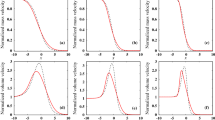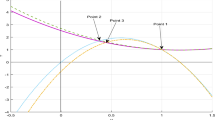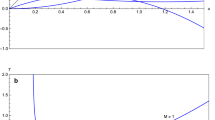Abstract
Generalized hydrodynamic equations were originally proposed to describe the rarefied non-equilibrium flows beyond the Navier–Stokes–Fourier (NSF) equations by constructing a non-equilibrium canonical distribution function for the mesoscopic Boltzmann equation. Subsequently, nonlinear coupled constitutive relations (NCCR) were developed under the adiabatic assumption, the Eu’s closure, and Myong’s simplification. NCCR+ was also proposed to include the omitted terms in Myong’s simplification. The goal of this paper is to assess the improvements in the accuracy due to NCCR+ and the influence of the bulk viscosity in one-dimensional steady shock wave structure for monatomic and diatomic gases. In order to solve NCCR+ equations, a coupled solution process based on the time-independent method for non-conserved variables is employed, which is different from the previous uncoupled solution process used for the NCCR equations. Shock structures in argon and nitrogen are calculated up to Mach 50, where the shock profile, inverse shock thickness, asymmetry parameter, and temperature–density separation distance are validated by DSMC and available experimental measurements. The results show that NCCR+ could not provide much improvement in accuracy compared to NCCR but adds to the computational cost, suggesting that Myong’s simplification used in NCCR is satisfactory. Both NCCR and NCCR+ perform better than NSF in computing the one-dimensional shock wave structure at high Mach numbers. It is also shown that the bulk viscosity has significant influence on the accuracy of prediction of the shock wave structure in a diatomic gas using both NSF and NCCR. Stokes’ hypothesis in conventional NSF is valid only for flows in a monatomic gas and for very low Mach number flows in a diatomic gas. Additionally, it is also found that the viscosity exponent s = 0.81 in variable-hard-sphere model provides a good fit with the experimental data for shock wave in argon using NCCR.






Similar content being viewed by others
References
Alsmeyer, H.: Density profiles in argon and nitrogen shock waves measured by the absorption of an electron beam. J. Fluid Mech. 74(3), 497–513 (1976). https://doi.org/10.1017/S0022112076001912
Steinhilper, E.A.: Electron beam measurements of the shock wave structure. Part I. The inference of intermolecular potentials from shock structure experiments. Part II. The influence of accommodation on reflecting shock waves. PhD Dissertation, California Institute of Technology (1972)
Bird, G.A.: Aspects of the structure of strong shock waves. Phys. Fluids 13(5), 1172–1177 (1970). https://doi.org/10.1063/1.1693047
Ohwada, T.: Structure of normal shock waves: Direct numerical analysis of the Boltzmann equation for hard-sphere molecules. Phys. Fluids A 5(1), 217–234 (1993). https://doi.org/10.1063/1.858777
Torrilhon, M., Struchtrup, H.: Regularized 13-moment equations: shock structure calculations and comparison to Burnett models. J. Fluid Mech. 513, 171–198 (2004). https://doi.org/10.1017/S0022112004009917
Fiscko, K.A.: Study of continuum higher order closure models evaluated by a statistical theory of shock structure. PhD Dissertation, Stanford of University (1988)
Xu, K., Huang, J.-C.: An improved unified gas-kinetic scheme and the study of shock structures. IMA J. Appl. Math. 76(5), 698–711 (2011). https://doi.org/10.1093/imamat/hxr002
Bird, G.A.: Molecular Gas Dynamics and the Direct Simulation of Gas Flows. Issue 42 of the Oxford Engineering Science Series. Oxford University Press, Oxford (1994)
Grad, H.: Asymptotic theory of the Boltzmann equation. Phys. Fluids 6(2), 147–181 (1963). https://doi.org/10.1063/1.1706716
Bhatnagar, P.L., Gross, E.P., Krook, M.: A model for collision processes in gases. I. Small amplitude processes in charged and neutral one-component systems. Phys. Rev. 94(3), 511–525 (1954). https://doi.org/10.1103/PhysRev.94.511
Broadwell, J.E.: Study of rarefied shear flow by the discrete velocity method. J. Fluid Mech. 19(3), 401–414 (1964). https://doi.org/10.1017/S0022112064000817
Huang, A.B., Giddens, D.P., Bagnal, C.W.: Rarefied gas flow between parallel plates based on the discrete ordinate method. Phys. Fluids 10(3), 498–502 (1967). https://doi.org/10.1063/1.1762143
Burnett, D.: The distribution of molecular velocities and the mean motion in a non uniform gas. Proc. Lond. Math. Soc. 40(1), 382–435 (1936). https://doi.org/10.1112/plms/s2-40.1.382
Zhao, W., Chen, W., Agarwal, R.K.: Formulation of a new set of Simplified Conventional Burnett equations for computation of rarefied hypersonic flows. Aerosp. Sci. Technol. 38, 64–75 (2014). https://doi.org/10.1016/j.ast.2014.07.014
Grad, H.: On the kinetic theory of rarefied gases. Commun. Pure Appl. Math. 2(4), 331–407 (1949). https://doi.org/10.1002/cpa.3160020403
Struchtrup, H., Torrilhon, M.: Regularization of Grad’s 13 moment equations: Derivation and linear analysis. Phys. Fluids 15(9), 2668–2680 (2003). https://doi.org/10.1063/1.1597472
Gu, X., Emerson, D.R.: A high-order moment approach for capturing non-equilibrium phenomena in the transition regime. J. Fluid Mech. 636, 177–216 (2009). https://doi.org/10.1017/S002211200900768X
Comeaux, K.A., Chapman, D.R., Maccormack, R.W.: An analysis of the Burnett equations based on the second law of thermodynamics. 33rd Aerospace Sciences Meeting and Exhibit, Reno, NV, AIAA Paper 1995-0415 (1995). https://doi.org/10.2514/6.1995-415
Grad, H.: The profile of a steady plane shock wave. Commun. Pure Appl. Math. 5(3), 257–300 (1952). https://doi.org/10.1002/cpa.3160050304
Grad, H.: Principles of the kinetic theory of gases. In: Thermodynamik der Gase/Thermodynamics of Gases, pp. 205–294. Springer, Berlin (1958). https://doi.org/10.1007/978-3-642-45892-7_3
Torrilhon, M.: Characteristic waves and dissipation in the 13-moment-case. Contin. Mech. Thermodyn. 12(5), 289–301 (2000). https://doi.org/10.1007/s001610050138
Torrilhon, M.: Modeling nonequilibrium gas flow based on moment equations. Annu. Rev. Fluid Mech. 48(1), 429–458 (2016). https://doi.org/10.1146/annurev-fluid-122414-034259
Eu, B.C.: Kinetic Theory and Irreversible Thermodynamics. Wiley, New York (1992)
Eu, B.C.: Nonequilibrium Statistical Mechanics: Ensemble Method, vol. 93. Kluwer Academic Publishers, Dordrecht (1998). https://doi.org/10.1007/978-94-017-2438-8
Myong, R.S.: A generalized hydrodynamic computational model for rarefied and microscale diatomic gas flows. J. Comput. Phys. 195(2), 655–676 (2004). https://doi.org/10.1016/j.jcp.2003.10.015
Myong, R.S.: Thermodynamically consistent hydrodynamics computational models for high-Knudsen-number gas flows. Phys. Fluids 11(9), 2788–2802 (1999). https://doi.org/10.1063/1.870137
Myong, R.S.: A computational method for Eu’s Generalized Hydrodynamic Equations of rarefied and microscale gasdynamics. J. Comput. Phys. 168(1), 47–72 (2001). https://doi.org/10.1006/jcph.2000.6678
Jiang, Z., Chen, W., Zhao, W.: Numerical simulation of three-dimensional high-speed flows using a second-order nonlinear model. 21st AIAA International Space Planes and Hypersonics Technologies Conference, Xiamen, China, AIAA Paper 2017-2346 (2017). https://doi.org/10.2514/6.2017-2346
Jiang, Z., Chen, W., Zhao, W.: Numerical analysis of the micro-Couette flow using a non-Newton–Fourier model with enhanced wall boundary conditions. Microfluid. Nanofluid. 22(1), 10 (2017). https://doi.org/10.1007/s10404-017-2028-y
Al-Ghoul, M., Eu, B.C.: Generalized hydrodynamic theory of shock waves: Mach-number dependence of inverse shock width for nitrogen gas. Phys. Rev. Lett. 86(19), 4294 (2001). https://doi.org/10.1103/PhysRevLett.86.4294
Al-Ghoul, M., Eu, B.C.: Generalized hydrodynamics and shock waves. Phys. Rev. E 56, 2981–2992 (1997). https://doi.org/10.1103/PhysRevE.56.2981
Myong, R.S.: On the high Mach number shock structure singularity caused by overreach of Maxwellian molecules. Phys. Fluids 26(5), 056102 (2014). https://doi.org/10.1063/1.4875587
Liou, M.-S.: A sequel to AUSM: AUSM+. J. Comput. Phys. 129(2), 364–382 (1996). https://doi.org/10.1006/jcph.1996.0256
Wada, Y., Liou, M.-S.: An accurate and robust flux splitting scheme for shock and contact discontinuities. SIAM J. Sci. Comput. 18(3), 633–657 (1997). https://doi.org/10.1137/S1064827595287626
Kim, K.H., Kim, C., Rho, O.-H.: Methods for the accurate computations of hypersonic flows: I. AUSMPW+ scheme. J. Comput. Phys. 174(1), 38–80 (2001). https://doi.org/10.1006/jcph.2001.6873
Camac, M.: Argon shock structure. In: de Leeuw, J.H. (ed.) The Fourth International Symposium on Rarefied Gas Dynamics, Toronto, 1965 1964, p. 240
Robben, F., Talbot, L.: Measurement of shock wave thickness by the electron beam fluorescence method. Phys. Fluids 9(4), 633–643 (1966). https://doi.org/10.1063/1.1761728
Linzer, M., Hornig, D.F.: Structure of shock fronts in argon and nitrogen. Phys. Fluids 6(12), 1661–1668 (1963). https://doi.org/10.1063/1.1711007
Boyd, I.D., Chen, G., Candler, G.V.: Predicting failure of the continuum fluid equations in transitional hypersonic flows. Phys. Fluids 7(1), 210–219 (1995). https://doi.org/10.1063/1.868720
Acknowledgements
This research was funded by the National Natural Science Foundation of China (Grant Nos. 11502232, 51575487, 11572284, and 61627901) and the National Basic Research Program of China (Grant No. 2014CB340201). The first author of this paper (Zhongzheng Jiang) gratefully acknowledges the support of China Scholarship Council (Grant No. 201706320214). Furthermore, he would also like to thank Manuel Torrilhon and his group for their hospitality and Mathematics Division in the Center for Computational Engineering Science at RWTH Aachen University for providing the resources during his stay as joint-training Ph.D. student.
Author information
Authors and Affiliations
Corresponding author
Additional information
Communicated by C.-H. Chang.
Rights and permissions
About this article
Cite this article
Jiang, Z., Zhao, W., Chen, W. et al. Computation of shock wave structure using a simpler set of generalized hydrodynamic equations based on nonlinear coupled constitutive relations. Shock Waves 29, 1227–1239 (2019). https://doi.org/10.1007/s00193-018-0876-3
Received:
Revised:
Accepted:
Published:
Issue Date:
DOI: https://doi.org/10.1007/s00193-018-0876-3




